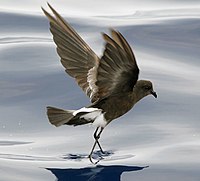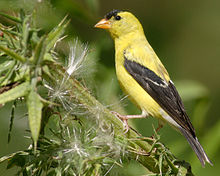List of birds of Maine
Unless otherwise noted, all species listed below are considered to occur regularly in Maine as permanent residents, summer or winter visitors, or migrants.
These birds are adapted to an aquatic existence with webbed feet, bills which are flattened to a greater or lesser extent, and feathers that are excellent at shedding water due to special oils.
With wingspans of 1.5–1.8 meters (almost 6 feet), the turkeys are the largest birds in the open forests in which they live and are rarely mistaken for any other species.
Order: Apodiformes Family: Apodidae The swifts are small birds which spend the majority of their lives flying.
Order: Apodiformes Family: Trochilidae Hummingbirds are small birds capable of hovering in mid-air due to the rapid flapping of their wings.
The most typical family members occupy dense vegetation in damp environments near lakes, swamps, or rivers.
Order: Charadriiformes Family: Haematopodidae The oystercatchers are large, obvious, and noisy plover-like birds, with strong bills used for smashing or prising open molluscs.
They are small to medium-sized birds with compact bodies, short thick necks, and long, usually pointed, wings.
Different lengths of legs and bills enable multiple species to feed in the same habitat, particularly on the coast, without direct competition for food.
Order: Charadriiformes Family: Stercorariidae They are in general medium to large birds, typically with gray or brown plumage, often with white markings on the wings.
Order: Charadriiformes Family: Alcidae Alcids are superficially similar to penguins due to their black-and-white colors, their upright posture, and some of their habits.
Order: Phaethontiformes Family: Phaethontidae Tropicbirds are slender white birds of tropical oceans with exceptionally long central tail feathers.
Order: Procellariiformes Family: Oceanitidae The storm-petrels are the smallest seabirds, relatives of the petrels, feeding on planktonic crustaceans and small fish picked from the surface, typically while hovering.
Order: Procellariiformes Family: Procellariidae The Procellariids are the main group of medium-sized "true petrels", characterized by united nostrils with medium septum and a long outer functional primary.
Order: Ciconiiformes Family: Ciconiidae Storks are large, heavy, long-legged, long-necked wading birds with long stout bills and wide wingspans.
Order: Suliformes Family: Phalacrocoracidae Cormorants are medium-to-large aquatic birds, usually with mainly dark plumage and areas of colored skin on the face.
Order: Pelecaniformes Family: Pelecanidae Pelicans are very large water birds with a distinctive pouch under their beak.
Order: Strigiformes Family: Strigidae Typical owls are small to large solitary nocturnal birds of prey.
Order: Coraciiformes Family: Alcedinidae Kingfishers are medium-sized birds with large heads, long pointed bills, short legs, and stubby tails.
Order: Piciformes Family: Picidae Woodpeckers are small to medium-sized birds with chisel-like beaks, short legs, stiff tails, and long tongues used for capturing insects.
Order: Passeriformes Family: Tyrannidae Tyrant flycatchers are Passerine birds which occur throughout North and South America.
Order: Passeriformes Family: Alaudidae Larks are small terrestrial birds with often extravagant songs and display flights.
Order: Passeriformes Family: Bombycillidae The waxwings are a group of birds with soft silky plumage and unique red tips to some of the wing feathers.
Order: Passeriformes Family: Polioptilidae These dainty birds resemble Old World warblers in their structure and habits, moving restlessly through the foliage seeking insects.
The gnatcatchers are mainly soft bluish gray in color and have the typical insectivore's long sharp bill.
Order: Passeriformes Family: Troglodytidae Wrens are small and inconspicuous birds, except for their loud songs.
Order: Passeriformes Family: Sturnidae Starlings are small to medium-sized Old World passerine birds with strong feet.
Order: Passeriformes Family: Turdidae The thrushes are a group of passerine birds that occur mainly but not exclusively in the Old World.
Order: Passeriformes Family: Icteriidae This species was historically placed in the wood-warblers (Parulidae) but nonetheless most authorities were unsure if it belonged there.
Order: Passeriformes Family: Parulidae The wood-warblers are a group of small often colorful passerine birds restricted to the New World.



















